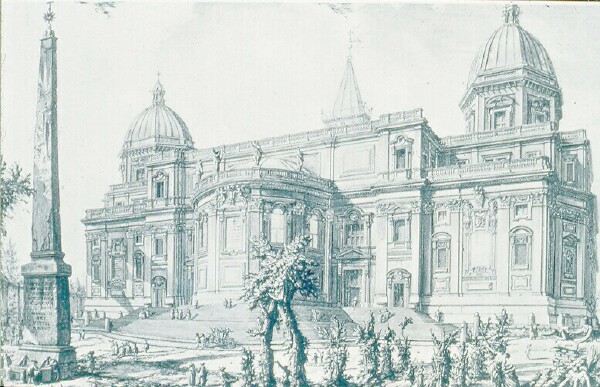OBELISKS IN AUGUSTAN ROME
Pliny, Historia Naturalis 36. 14 (69):
[Mesphres =Thutmose III. One of these latter obelisks is Cleopatra's Needle.]
Seti I/Rameses II; the one on Montecitorio was commissioned by Psammetichus II.]
Suetonius Augustus 104:
Strabo Geography 5. 3.8:
Curiosum Urbis Romae
[Valentini & Zuchetti, Codice topografico della città di Roma I (1940) 149]in Musileo Augusti duo altae singulae pedes XLII semis.

The Esquiline Obelisk
- seen in city plans of Bufalini (1551) and Duperac (1577) lying in at least four pieces between the Mausoleum and the river, now the Via Ripetta . Duperac's drawing of ca. 1575 shows the obelisk without the benben.
- first excavation, July 14, 1519 (Lanciani, Storia degli scavi di Roma (Roma 1902-1912) I, 192.)
- Baldassare Peruzzi and Antonio da Sangallo immediately studied and sketched the obelisk (A. Bartoli, I monumenti antichi di Roma nei designi degli Uffizi di Firenze [Roma 1914-1922] II #201 and 202; III #355, 412, 420.).
- The second is referred to in 1527 by Andrea Fulvio, Antichità di Roma (Antiquitates Urbis 1527; translated by Ferrucci 1588, 138).
- In September 1585 Pope Sixtus V (Peretti) ordered the removal of the obelisk to the rear of S. Maria Maggiore. This work was carried out by Badino da Stabia. F. Artaud de Montor, Histoire des souverains pontifes romains IV (Paris 1851) 372-377.
- Space was obtained by the demolition of two churches, S. Alberto and S. Luca. Foundations for the obelisk were under way by March 11, 1587.
- Erection of the obelisk was completed under the direction of Domenico Fontana (who had moved and reerected the Vatican Obelisk in the previous year) and Carlo Maderno on July 29, 1587.
- Consecration of the obelisk took place on August 13, 1587, in the presence of the pope.
- The cornice, star, and cross were cast by Giacomo Tranquilli to designs of Giacomo della Duca.

Bufalini's map of 1551, with the obelisks
lying in the street next to the Tiber
Inscriptions:
(S) CHRISTVS PER INVICTAM CRVCEM POPVLO PACEM PRAEBEAT
QVI AVGVSTI PACE IN PRAESEPE NASCI VOLVIT.
(N) CHRISTVM DOMINVM QVEM AVGVSTVS DE VIRGINE NASCITVRVM
VIVENS ADORAVIT SEQ DEINCEPS DOMINVM DICI VETVIT ADORO.
(E) CHRISTI DEI IN AETERNVM VIVENTIS CVNABVLA LAETISSIME
COLO QVI MORTVI SEPVLCRO AVGVSTI TRISTIS SERVIEBAM.
(W) SIXTVS V PONT MAX OBELISCVM AEGYPTO ADVECTVM AVGVSTO
IN EIVS MAVSOLEO DICATVM EVERSVM DEINDE IN PLVRES
CONFRACTVM PARTES IN VIA AD SANCTVM ROCHEM IACENTEM
IN PRISTINAM FACIEM RESTITVTVM SALVTIFERAE CRVCI
FELICIVS HIC ERIGI IVSSIT A D MDLXXXVII PONT III.